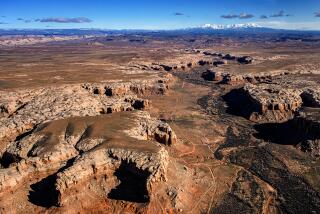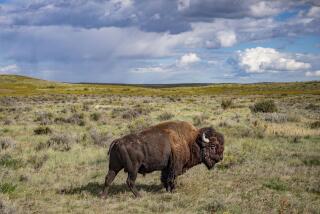Tribes Join Battle to Preserve Bisons’ Mythic Quality
- Share via
The Plains Indians think of the buffalo as part of their extended family. The animals are called Buffalo People, dubbed brother and grandfather, and considered to have equal tenancy of the land.
“The Buffalo People have a relationship of their own to the natural world. They have locality, relationships and religion,” said Ed Valandra, a Lakota Sioux writer and activist. “When you talk about people, you’re talking about relationships. Our definition of what a people is, is more encompassing.”
Skip Sayers appreciates the buffalo’s mythic quality. But the president of the American Bison Assn. sees a practical side to the animal.
“I’d be raising them because of their antics and the Old West heritage,” he said. “But when I get $1.25 to $1.50 a pound for bison while I would do well to get 85 cents for cattle, it doesn’t take a rocket scientist to figure out the advantage.”
Sayers, a Missouri-based entrepreneur, ticks off other advantages with the salesmanship of a car dealer. Bison, he says, are easier to raise. Unlike cattle, they can survive harsh winter weather, feed and water themselves in snowy fields and give birth with fewer complications.
Bison meat is low in cholesterol and fat, high in vitamins. The additional uses of buffalo hides and skulls make for a lucrative mix of products.
Sayers sees no downside to this commercialization of the animal.
“The more people eat bison, the more bison you’ll have,” he said.
*
But this notion bothers those who see the imposition of cattle breeding and other techniques on buffalo as continued exploitation of an animal with deep spiritual significance.
For tribes now reintroducing buffalo on their lands, there is strong resistance to such practices as feedlots, breeding out naturally aggressive or independent animals, dehorning to prevent injuries, and shipping herds to slaughterhouses.
“When we look at what happened in the last 30 years of the 19th Century, it is a real responsibility for the Lakota people to ask the buffalo to come back,” Valandra said.
More to Read
Sign up for Essential California
The most important California stories and recommendations in your inbox every morning.
You may occasionally receive promotional content from the Los Angeles Times.













